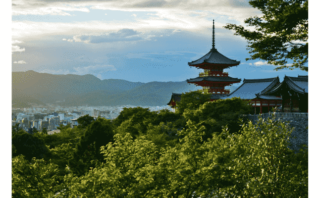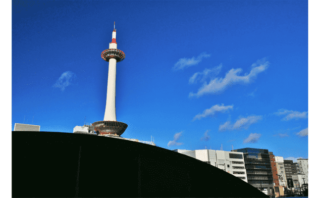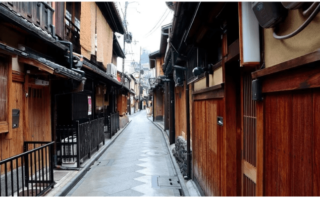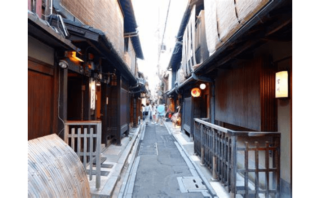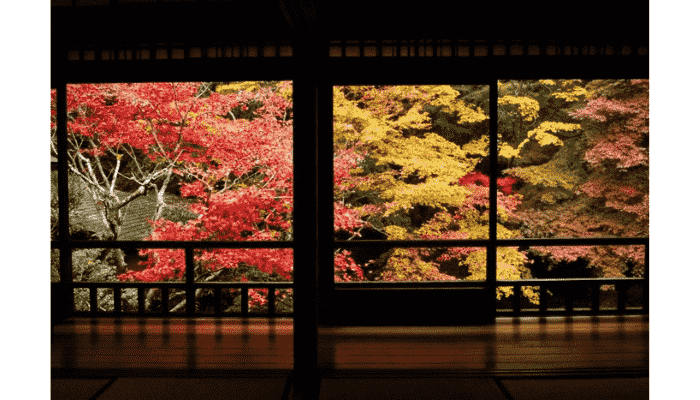Sanjusangendo Temple in Kyoto, officially known as Rengeo-in Sanjusangendo, is one of the city’s most famous landmarks.
Located just a 15-minute walk or an 8-minute bus ride from Kyoto Station, it’s easily accessible for visitors. The highlight of this temple is its National Treasure main hall, where over 1,000 stunning Buddhist statues stand in rows, creating a breathtaking sight.
Beyond the main hall, the temple grounds feature a beautiful garden that changes with the seasons, along with many other attractions.
If you’re planning a visit, consider exploring nearby sightseeing spots and trying some local food to make the most of your trip!
What is Sanjusangendo?

Sanjusangendo Temple, located in Kyoto, was originally built as part of Hojudono, the residence of Emperor Go-Shirakawa.
Its official name is Rengeo-in Hondo (Main Hall of Rengeo-in). The temple gets its name, Sanjusangendo, from its unique architectural design—inside the hall, there are 33 spaces between the columns.
The current structure was rebuilt in 1266 during the Kamakura period, after the original temple was lost in a fire. This National Treasure temple houses an incredible 1,001 statues of Kannon, the Goddess of Mercy, including the seated Thousand-Armed Kannon statue, which is also designated as a National Treasure.
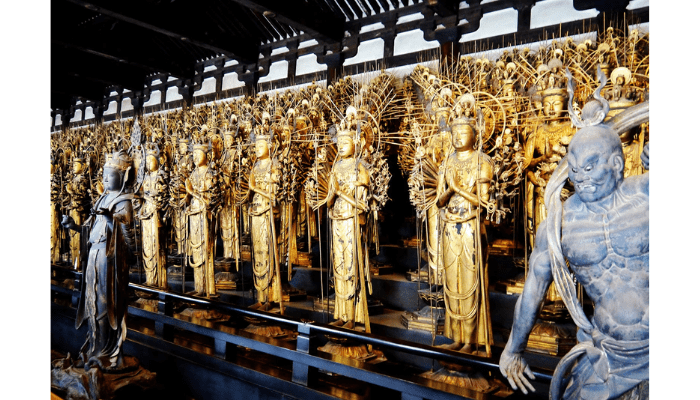
The rows of standing Kannon statues, stretching across 10 rows from front to back, create a breathtaking scene often described as a “forest of Buddha statues.”
Legend says that among these statues, you might find one that resembles someone you wish to meet.
In 2018, the Kannon statues inside the hall were elevated from Important Cultural Property to National Treasure status, bringing even more attention to Sanjusangendo.
Beyond the main hall, the temple grounds offer hidden gems that many visitors overlook, making it a great place to explore at a relaxed pace.
Sanjusangendo Visitor Information
- Address: 657 Sanjusangendo Mawari-cho, Higashiyama-ku, Kyoto
- Map: [Google Maps]
- Phone: 075-561-3334
- Open Year-Round (No closing days)
- Opening Hours:
- March 31 – November 15: 8:00 AM – 5:00 PM
- November 16 – March 30: 9:00 AM – 4:00 PM
- Admission Fees:
- Adults: 600 yen
- Middle & High School Students: 400 yen
- Children: 300 yen
Things to Know Before You Visit
- The temple grounds are wheelchair and stroller-friendly, with accessible restrooms, flat paths, and ramps.
- Photography is allowed outside the main hall but prohibited inside.
- Visitors must remove their shoes before entering the main hall, so wearing easy-to-remove footwear is recommended.
How to Get to Sanjusangendo
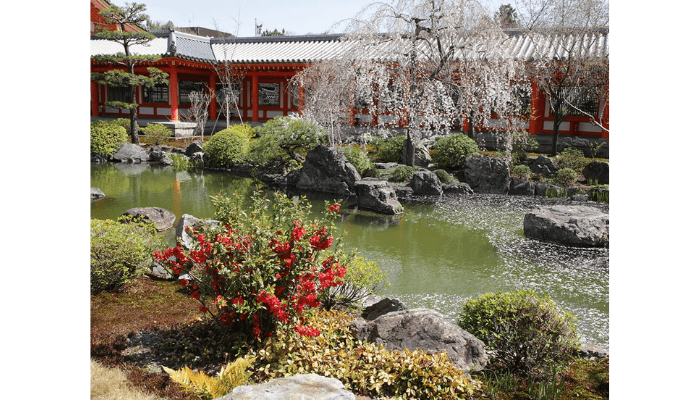
Sanjusangendo is a conveniently located sightseeing spot near Kyoto Station. You can reach it using various transportation options, including public transit, walking, or cycling.
By Foot
- From Kyoto Station, it takes about 15 minutes to walk.
By Bus
- Take Kyoto City Bus #206 or #208 from Kyoto Station and get off at “Hakubutsukan Sanjusangendo-mae” bus stop. The temple is just a 1-minute walk from there.
- If you plan to explore Kyoto by bus, consider purchasing a 1-day bus pass for unlimited rides. Many tourists find buses to be the most convenient way to get around.
By Train
- From Kyoto Station (JR Line): 15-minute walk
- From Keihan Shichijo Station (Keihan Line): 7-minute walk
By Bicycle
Kyoto has many rental bicycle shops, making cycling a great way to explore. If you come by bike, be sure to use the designated bicycle parking area inside the temple grounds.
The History of Sanjusangendo
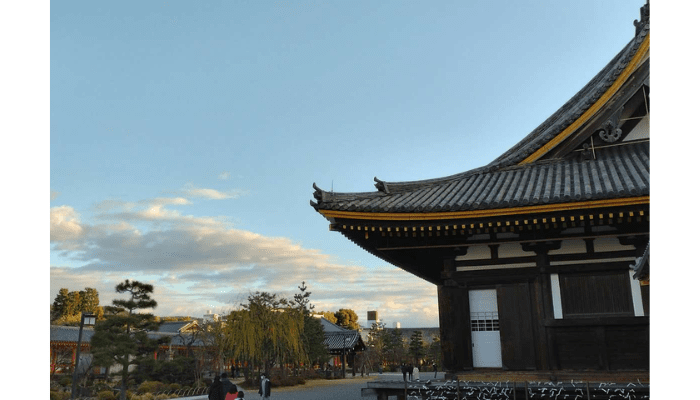
Sanjusangendo is a historic Buddhist temple in Kyoto, completed on January 30, 1165.
Originally, the temple complex included a five-story pagoda, but it was destroyed by fire in 1249. The current hall was rebuilt in 1266 during the Kamakura period and is now designated as a National Treasure due to its cultural and architectural significance.
Throughout history, Sanjusangendo has been supported by Emperor Go-Shirakawa and Toyotomi Hideyoshi, two important figures in Japanese history. Over the centuries, the temple has undergone renovations while preserving its original form.
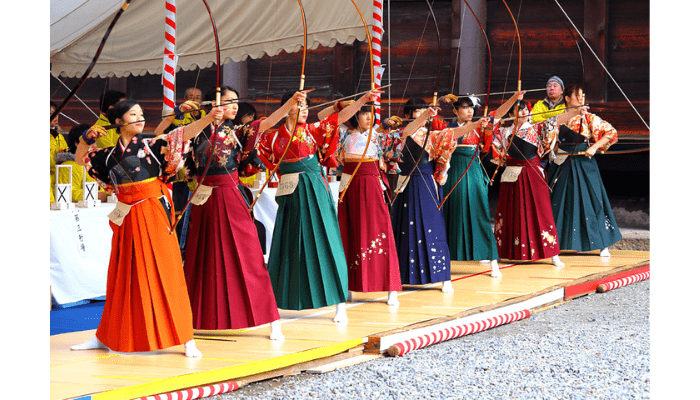
During the Momoyama and Edo periods, Sanjusangendo was known for “Tōshiya”, a legendary archery competition.
- In the Momoyama period, archers aimed to shoot arrows through a small window gap in the 120-meter-long hall in events called “Hyakusha” (100 shots) and “Sensha” (1,000 shots).
- In the Edo period, the focus shifted to a competition called “Ōyazume,” where participants shot as many arrows as possible under the temple’s eaves within 24 hours.
Today, visitors can learn about these historical events through exhibits and displays inside the temple.
Highlights of Sanjusangendo
Sanjusangendo is home to several National Treasures, including the wooden seated statue of Senju Kannon (Thousand-Armed Kannon) and 1,000 standing Kannon statues lined up in a breathtaking display.
Since photography is not allowed inside, you must visit in person to witness this awe-inspiring sight.
1. 1,001 Buddhist Statues in the Main Hall
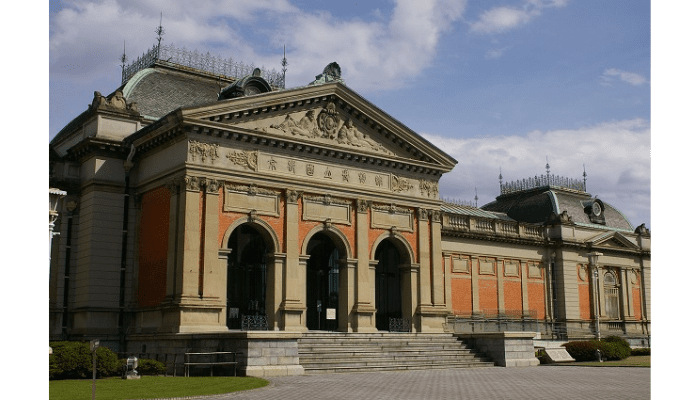
Sanjusangendo is a popular tourist attraction visited by both travelers and student groups. The ticket booth is lively, and if you’re walking from Kyoto Station, use the Kyoto National Museum as a landmark to find your way. If you take the bus, it’s only a 1-minute walk from the bus stop to the entrance.

The main hall is the highlight of the temple, where 1,001 Buddhist statues create an unforgettable scene.
At both ends of the hall, you’ll find the statues of Fujin (Wind God) and Raijin (Thunder God), known for their dynamic expressions and powerful postures.
At the center of the hall stands the seated statue of Senju Kannon, a masterpiece created by the famous sculptor Tankei.

Of the 1,001 Kannon statues, about 500 bear the names of the artisans who crafted them centuries ago. As you walk through the hall, take time to read the descriptive plaques about these sacred figures and the history of Sanjusangendo.
Although photography is not permitted, you are free to explore at your own pace—so take your time to fully appreciate the beauty of this sacred space.
Tips for Your Visit
- Removing Shoes: Visitors must remove their shoes before entering the hall. There are separate entrances for individual visitors and tour groups, so be sure to use the correct one.
- Souvenirs: Near the exit, you’ll find a shop selling souvenirs related to Sanjusangendo, making it a great place to pick up a memento of your visit.
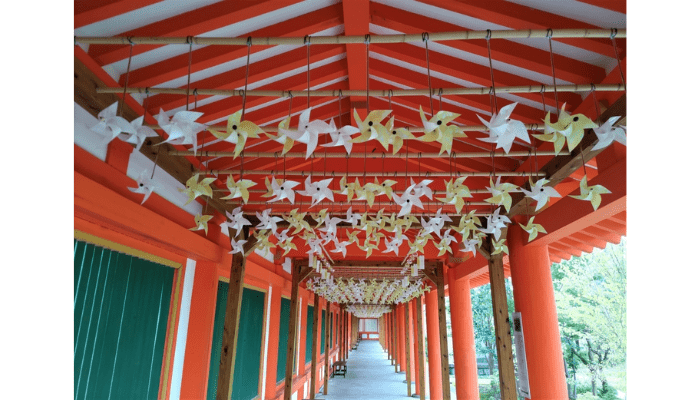
The temple grounds feature several resting areas with benches, making it easy to take a break. Even in the hot summer months, there are shaded spots with roofs to keep you cool.
Surrounded by vermilion-painted pillars and traditional architecture, the rest areas create a peaceful and authentic Kyoto atmosphere—a perfect place to relax and soak in the beauty of this historic site.
2. The Scenic Garden of Sanjusangendo

Sanjusangendo is famous for its stunning hall of 1,001 Kannon statues, but it also has several hidden gems that many visitors overlook.
One of them is a beautiful garden that stretches about 100 meters from the main entrance. Centered around a large pond, the garden offers seasonal beauty, with flowers blooming in spring and vibrant foliage in autumn.
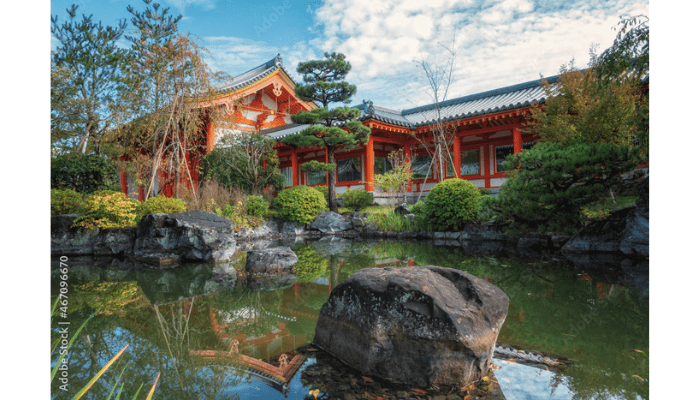
A peaceful walking path winds through the garden, surrounded by lush greenery. Strolling along this path feels like a forest bath, offering a refreshing escape from the temple’s more crowded areas.
Unlike the sacred halls filled with National Treasures and Buddhist statues, this garden area lets you connect with nature.
At the garden near the entrance, you’ll find a different atmosphere compared to the garden further along the path. The tree-lined walkway provides plenty of shade, making it an ideal spot to cool down during Kyoto’s hot summer months.
For those looking to experience both history and nature, this scenic garden is the perfect place to relax and unwind.
3. Hidden Spots Inside Sanjusangendo!
While most visitors focus on the 1,001 Kannon statues inside the temple hall, Sanjusangendo has many lesser-known spots worth exploring.
Before you leave, take a moment to visit these hidden gems around the temple grounds!
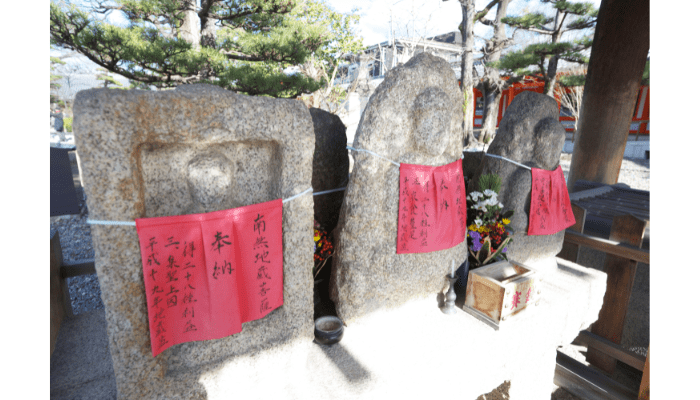
Near the entrance, you’ll find a small shrine tucked away in a corner, housing numerous Jizo statues.
A donation box is placed nearby, so you can offer a prayer before continuing your visit.
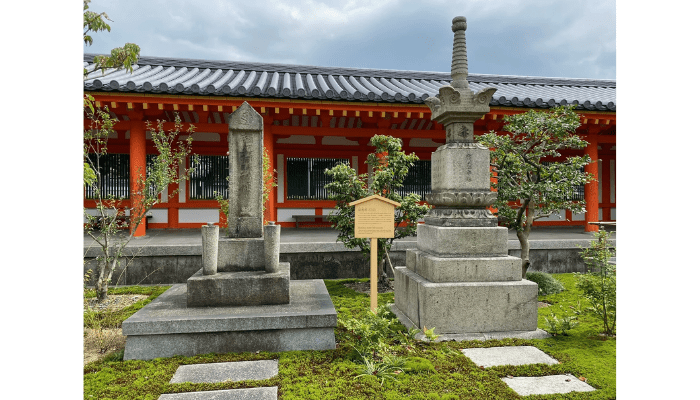
One of the most striking sights outside the hall is the Shakyo Honno-to, a tall stone monument standing gracefully toward the sky.
If you walk around the temple grounds, you’ll also come across memorials and a small shrine.
While the main hall is usually crowded, the surrounding areas tend to be much quieter, creating a peaceful, hidden-away atmosphere.
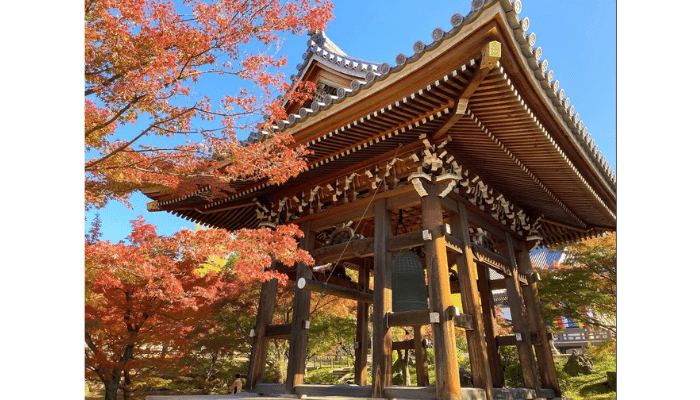
As you walk further back from the entrance, a large bell tower (Shoro) appears. While visitors cannot ring the bell, it makes for a great photo spot!
Continuing past the bell tower, you’ll reach an even quieter area behind the temple hall, far from the crowds.
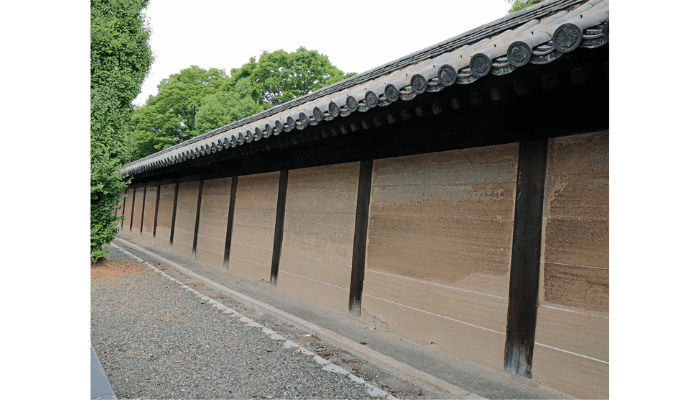
One of the most historical structures here is the Taiko Wall (Taiko-bei), which was donated by Toyotomi Hideyoshi, a famous samurai ruler.
This long clay wall, stretching across the temple grounds, is topped with roof tiles bearing the Toyotomi clan’s crest.

Close to the Taiko Wall, you’ll find the massive South Gate (Nandaimon), another Important Cultural Property.
If you walk further behind the temple, you’ll discover a hidden Inari Shrine, marked by a large stone torii gate.
This shrine is believed to bring good fortune in business, so be sure to walk through both torii gates and visit the main shrine building.
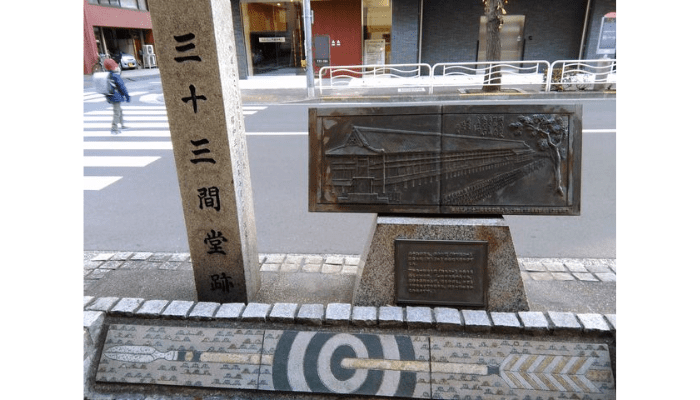
Throughout Sanjusangendo’s temple grounds, you’ll find many historical stone monuments.
Take a leisurely stroll to discover their meanings and connections to the temple’s long history.
After exploring the famous temple hall, these hidden gems offer a peaceful and enriching experience away from the crowds!
Sightseeing Spots Near Sanjusangendo
Sanjusangendo is located near Kyoto Station, making it an ideal starting point for exploring several nearby attractions.
Right across from the temple, you’ll find a museum and a famous Japanese garden, along with other cultural sites.
1. Higashi Honganji Temple

Located about an 8-minute walk from JR Kyoto Station and 15 minutes from Sanjusangendo, Higashi Honganji is one of Kyoto’s most significant temples.
This temple serves as the head temple of the Otani-ha sect of Jodo Shinshu Buddhism and enshrines Shinran Shonin, the founder of the sect.
At the heart of the temple grounds is the Goeido Hall, a sacred space that visitors can enter. Inside, you’ll find an image of Shinran Shonin, surrounded by a solemn and spiritual atmosphere.
Next to it stands the Amida Hall, which is also open for worship.
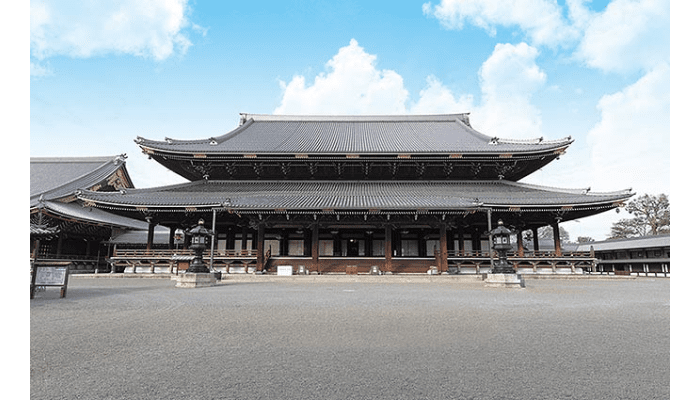
The spacious temple grounds feature many fascinating structures, but one of the most striking is the Goeido Gate, the grand entrance to the temple.
With its imposing traditional architecture, this gate is a popular photo spot for visitors.
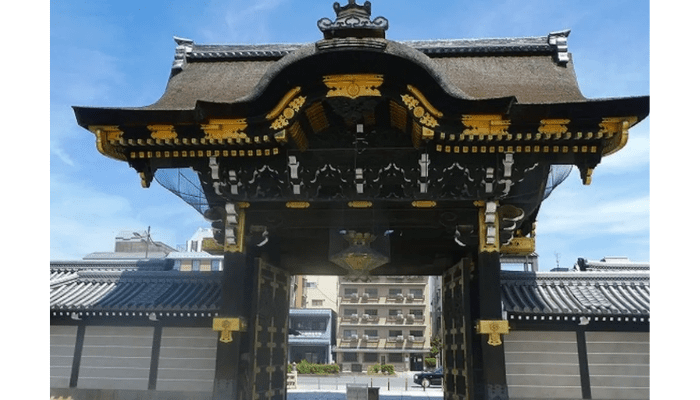
About a 10-minute walk from Higashi Honganji is Nishi Honganji, another major temple of the Jodo Shinshu tradition.
Although the two temples share similar architectural styles, each has unique features.
If you have time, visiting both temples is a great way to compare their differences and appreciate Kyoto’s rich Buddhist heritage.
Higashi Honganji
- Address: Karasuma-dori, Shichijo Agaru, Shimogyo-ku, Kyoto
- Google Maps: [Click here]
- Access: 8-minute walk from JR Kyoto Station
- Phone: 075-371-9210
- Open year-round
- Opening Hours:
- March–October: 5:50 AM – 5:30 PM
- November–February: 6:20 AM – 4:30 PM
- Admission: Free
- Official Website: Higashi Honganji
2. Shosei-en
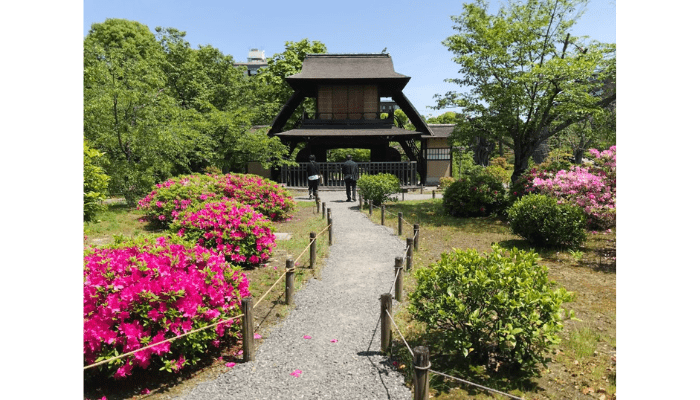
Shosei-en is a traditional Japanese garden located about a 10-minute walk from JR Kyoto Station.
Part of Higashi Honganji Temple’s precincts, this garden offers a serene escape where visitors can enjoy the beauty of nature.
If you love photography or appreciate scenic landscapes, this is a must-visit spot.
When I visited just before the rainy season, I was mesmerized by the sight of lotus leaves floating on the central pond—a truly peaceful scene.
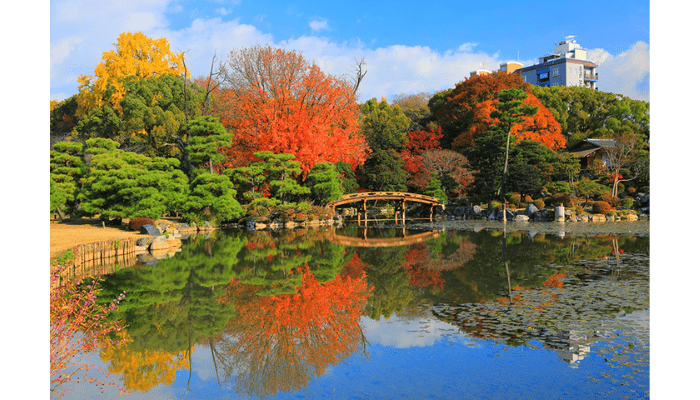
The spacious grounds are centered around a pond, providing many picturesque waterside views.
One of the most relaxing spots is the area along a small stream, where lush greenery creates a cool and tranquil atmosphere.
The garden also features unique architectural structures, such as Bokakaku Pavilion, known for its distinctive design.
Be sure to explore and capture its photo-worthy landscapes and traditional buildings!
Shosei-en
- Address: Higashitamamizu-cho, Shimogyo-ku, Kyoto
- Google Maps: [Click here]
- Access: 10-minute walk from JR Kyoto Station
- Phone: 075-371-9210
- Open year-round
- Opening Hours:
- March–October: 9:00 AM – 5:00 PM
- November–February: 9:00 AM – 4:00 PM
- Admission Fee:
- Adults: 500 yen
- High school students and younger: 250 yen
- Official Website: Shosei-en
3. Kyoto National Museum

Located just in front of Sanjusangendo Temple and about a 15-minute walk from JR Kyoto Station, Kyoto National Museum is a prestigious national museum showcasing the rich cultural heritage of Kyoto.
The museum’s striking red brick exterior stands out, and inside, visitors can explore exhibitions featuring Kyoto’s history and arts from the Heian to Edo periods.
As of June 30, 2019, the permanent exhibition is temporarily closed, but the museum hosts rotating special exhibitions throughout the year.
These exhibitions change themes regularly, covering a wide range of artifacts, from Buddhist statues and paintings to national treasures and important cultural properties.
Since most of the exhibits are indoors, the museum is also a great spot to visit on a rainy day!
Kyoto National Museum
- Address: 527 Chaya-cho, Higashiyama-ku, Kyoto
- Google Maps: [Click here]
- Access: 15-minute walk from Kyoto Station / Short walk from “Hakubutsukan Sanjusangendo-mae” bus stop
- Phone: 075-525-2473
- Closed: Mondays & New Year holidays
- Opening Hours:
- 9:30 AM – 6:00 PM (Last entry at 5:30 PM)
- Fridays & Saturdays: Open until 8:00 PM
- Admission Fee: Varies by exhibition
- (e.g., for “National Treasure: Ippen Hijiri-e and Treasures of the Jishu School” – Adults: 1,500 yen, University students: 1,200 yen, High school students: 700 yen)
- Official Website: Kyoto National Museum
Best Places to Eat Near Sanjusangendo
There are many great restaurants around Sanjusangendo, offering a variety of delicious dishes.
1. IL PAPPALARDO

Located just a 7-minute walk from Keihan Shichijo Station and within walking distance from Sanjusangendo, IL PAPPALARDO is a must-visit Italian restaurant.
One of the highlights of this restaurant is its open kitchen, where you can watch the chefs prepare your meal. The specialty here is authentic Neapolitan pizza, baked in a traditional oven.
For lunch, the “Pranzo A” set (1,800 yen, tax included) lets you choose between pizza or pasta as the main dish.
If you’re a cheese lover, try the Quattro Formaggi pizza, generously topped with a rich blend of cheeses that nearly melts off the crust!
IL PAPPALARDO
- Address: 451-1 Myohoin Maegawacho, Higashiyama-ku, Kyoto
- Google Maps: [Click here]
- Access: 7-minute walk from Keihan Main Line Shichijo Station
- Phone: 075-533-3330
- Closed: Tuesdays & New Year holidays
- Opening Hours:
- Lunch: 11:30 AM – 3:00 PM (Last Order: 2:30 PM)
- Dinner: 5:30 PM – 10:00 PM (Last Order: 9:00 PM)
- Price Range:
- Lunch: 1,000 – 1,999 yen
- Dinner: 4,000 – 4,999 yen
- Smoking: Completely non-smoking
2. Okonomiyaki Kiraku Kiyomizu Gojozaka Branch

Located just a 10-minute walk from Keihan Kiyomizu-Gojo Station, Okonomiyaki Kiraku is a popular spot specializing in okonomiyaki (savory Japanese pancakes) and yakisoba (fried noodles).
This restaurant is open from lunch to dinner, making it a convenient stop whether you’re taking a break from sightseeing or looking for a hearty evening meal. It offers both table seating and counter seats for solo diners or couples.
The restaurant’s signature okonomiyaki is crispy on the outside and fluffy on the inside. A must-try is the “Butatama (Single)” for 700 yen (tax included), packed with the rich flavor of pork and the natural sweetness of vegetables.
For an extra layer of taste and texture, add a green onion topping, which brings a fresh crunch and a fragrant aroma to your dish!
Okonomiyaki Kiraku Kiyomizu Gojozaka Branch
- Address: Bellagio Kyoto Kiyomizu 1F, 562 Yugyo-mae-cho, Higashiyama-ku, Kyoto
- Google Maps: [Click here]
- Access: 10-minute walk from Keihan Main Line Kiyomizu-Gojo Station
- Phone: 075-541-1690
- Closed: Mondays
- Opening Hours:
- Lunch: 11:30 AM – 3:00 PM
- Dinner: 5:00 PM – 10:00 PM
- Price Range:
- Lunch: Up to 999 yen
- Dinner: 1,000 – 1,999 yen
- Smoking: Allowed
3. THE BORING FOODS & ordinary coffee

Located just a 2-minute walk from Kyoto Station’s Hachijo Exit, this botanical-themed restaurant is on the first floor of “Henn na Hotel.”
Offering a buffet-style dining experience from morning to evening, it allows guests to enjoy a variety of flavors using their favorite ingredients. Although it is inside a hotel, anyone is welcome to dine here, not just hotel guests.
For lunch, the “Lunch Buffet” (1,500 yen, tax included) lets you choose one main dish from rice, tacos, or a salad bowl. You can then customize your meal by adding items from the buffet.
With endless combinations of ingredients and flavors, you can create a meal that’s both delicious and visually appealing!
THE BORING FOODS & ordinary coffee
- Address: 15 Higashisan-ōchō, Higashikujo, Minami-ku, Kyoto
- Google Maps: [Click here]
- Access: 2-minute walk from JR Kyoto Station (Hachijo East Exit) / 2-minute walk from Subway Karasuma Line Kyoto Station (Hachijo East Exit)
- Phone: 050-3468-5127
- Closed: Irregular holidays
- Opening Hours:
- Breakfast: 7:00 AM – 11:00 AM (L.O. 10:30 AM)
- Lunch: 11:30 AM – 3:00 PM (L.O. 2:30 PM)
- Dinner: 3:00 PM – 11:30 PM (L.O. 11:00 PM)
- Price Range:
- Breakfast: 1,000 – 1,999 yen
- Lunch: 1,000 – 1,999 yen
- Dinner: 2,000 – 2,999 yen
- Smoking: Non-smoking
Sanjusangendo is home to many National Treasures and Important Cultural Properties. If you only plan to explore the main hall, it takes about 30 minutes, but if you want to see the entire temple grounds, set aside about an hour.
Located close to Kyoto Station, the temple is easy to visit as part of your sightseeing itinerary.
I hope this article helps you enjoy your visit to Sanjusangendo!
▼ Related Articles for Kyoto Sightseeing

